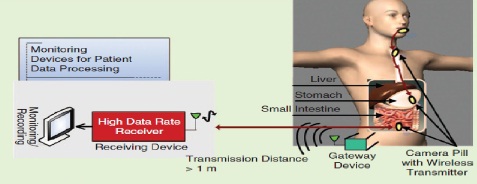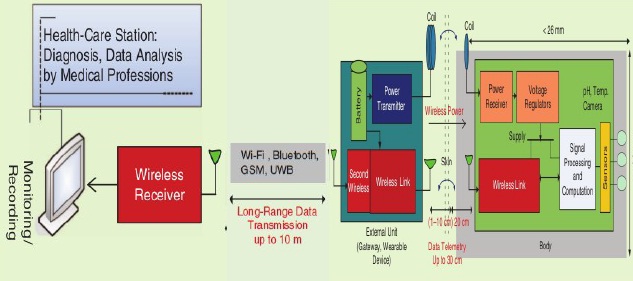Easy-To-Swallow Wireless Telemetry
Published on Nov 23, 2015
Abstract
A recent article gives a good history of capsules clinical implementation. The design of wireless capsules they have been called “endoradiosondes,” “capsules,” “smart pills,” “electronic “radio pills,” “wireless capsules,” “wireless Herein we will use the term “electronic pill” when referring early development, electronic pill and thus have a limited number of been ultra-high-frequency (UHF) around 400 MHz. technologies for wireless Given Imaging.
The pill uses the transmission in the medical implant communication MHz). The allowable channel bandwidth for this band is 300 kHz. It is difficult enough data rate for the high It is quite obvious that future electronic pills will target transmission that could facilitate pill technology is the wireless system design of the wireless telemetry unit for the electronic challenges and developments for successful based electronic pills. endoscopy) for a Figure 1.1
A wireless endoscope monitoring system. Easy-To-Swallow Wireless CHAPTER 1 Introduction from their early development to began in the 1950s. Since endoscopy,” “video capsules,” and so forth. to this technology. Sin designs have been based on narrowband camera pixels. Commonly used frequency values have One of current endoscope devices is commercially available by .
Zarlink’s radio frequency (RF) chip service (MICS) band (4 high-quality video data at the moment for realis highertransmission a better diagnosis. An important feature of the electronic utilized. This article reviews recent attempts in the pill technology and implementation of high-resolution Figure 1.1 shows an electronic pill system medical monitoring system Telemetry 1 then, pills,” Since its transmission state-of-the-art the company ’s for wireless 402–405 to assign -time monitoring. -bandwidth data also discusses videoshows (i.e., wireless endoscopy) for a medical monitoring system.

Wireless Telemetry Methods Used In Electronic Pills
The design of swallowable radio transmitters for use in diagnosis of the digestive organ system first appeared in the literature in 1957 by two different groups almost simultaneously. These early attempts were based on low-frequency transmission and with simple structures. A basic transmitter, using either Colpitts or Hartley oscillator topology connected to a sensor was used to send the signal from inside the body to external devices for tracking the physiological parameters of inner organs. Despite their simplicity, early systems were bulky because of the physically large electronic components and batteries at the time, in addition to the targeting of several diagnostic measures such as temperature, pH, and pressure .
The electronic pill device is placed deeply inside the body, which makes the wireless communication interesting due to its surrounding environment. Many designs have preferred lower-frequency transmissions [UHF-433 industrial, scientific and medical(ISM) or lower. Low-frequency transmission is easy to design and is attractive due to its high efficiency of transmission through layers of skin. A low frequency link, however, requires large electronic components such as capacitors and inductors, which makes it difficult to realize a fully integrated system. Recent significant technology improvements have enabled the design of smallsize cameras and batteries.
Thus, in the last ten years, some research projects looking at developing electronic pills have concentrated mostly on the visual sensor system. As a result, a high-frequency telemetry link is required for better resolution and a miniaturized system. Recent telemetry systems for the electronic pill technology given in Table 1.1 are still at prototype levels. In,a wireless endoscope system uses a commercial RF transceiver operating at 433 MHZ ISM with a 267 kb/s data rate. The electronic pill includes a passive wireless link used for wake-up to reduce power consumption. The wake-up system recovers energy from a 915 MHz RF modulated signal with some sort of identification code.
This capsule uses image compressing techniques with an application specific integrated circuit (ASIC) to enable a higher transmission rate of images for low– data rate systems. The pill in uses a simple on-off keying (OOK) wireless system. Similar to early developments, this device transfers physiological data, including pH and temperature. Another such device was developed by Valdastri et al., in with a multichannel feature to cover a few different physiological parameters. It was tested in vivo in pigs using pressure sensors and a transmission range of 5 m was reported. These devices do not require a high data rate when compared to the video based pills highlighted in Table 1.1; this is because physiological parameters, such as pH and temperature, are slowly varying and hence low-frequency signals.
Simple modulation schemes like OOK and amplitude shift keying (ASK) with a low data rate are desired for low power consumption and miniaturization. Another type of capsule is the robotic endoscope, which has features such as locomotion and the energy transmission using electromagnetic (EM) coupling. Wang et al.,adopted earthworm-like locomotion for their design. The device size is quite large when compared with other proposed systems because of this locomotion function. Similar to smart pill technology, this device can also be used for precise drug delivery in the human gastrointestinal tract.
Real-time wireless energy transfer via magnetic coupling is necessary for these types of endoscopes to provide mechanical function, as they require a large amount of power for continuous movement. A recent study demonstrated a prototyping system to achieve a high data rate transmission (2 Mb/s) for higher image resolution.
This systems enabled an image resolution up-to 15–20 frames/s using a compression technique similar to Joint Photograpic Experts Group. It uses a transmitter based on a Colpitts oscillator consisting of a small number of components and consuming little power. The device operates at 144 MHz, lower than most of the systems that are operating at UHF, but requiring a larger antenna that,in turn, will increase the physical size. In Parket al., also uses a simple amplitude modulation (AM).It is designed with a mixer and an oscillator circuit together with a CMOS image sensor and loop antenna to form a capsule-shaped telemetry device. This device uses an external control unit to control the capsule within the human body. The same group later developed a different version of their device that uses an electric stimulation technique to move the capsule up and down inside the small intestines.
The stimulating electrical voltage was controlled externally by adjusting the amplitude of the stimulating pulse signal and, thus, allowing movement of the capsule in the human gastrointestinal tract. This new system uses an ASK modulated signal at 434 MHz. Another category of electronic pill technology uses fluorescence spectroscopy and imaging, similar to those that are commercially available (see Table 4 studied a fluorescence-based electronic LEDs to obtain clearer images Due to the use of power hungry LEDs, such a device consumes more other systems. An alternative power the electronics.
Batteryless Electronic Pills
Currently, the battery, one of the essential components in electronic pills, provides the power source to the active electronic components in the device. Although small miniature rechargeable battery technologies are available, the lifetime they provide may not satisfy the desired operation time for detecting and transmitting enough useful data from inside the body. As given in Table 4.1, current electronic pills have limited operational time as a result of the battery technology used. One way to enhance this operational lifetime is to charge the battery wirelessly. Alternatively, a completely wireless power system could also be used. In batteryless systems, it is necessary to bring the charging transmitter very close to the patient’s skin to charge or energize the electronic pill.
Unlike conventional implant systems, longer-range wireless power transfer is required for electronic pills, which needs to transfer energy efficiently through the 15–20 cm thick skin in order to reach the device inside the body. Wirelessly energizing electronic pills was studied early in the development of the first electronic pills. One of the first electronic pills used an inductive link for wireless power transfer. The cylindrical shaped pill was 0.7 cm in diameter and 2.5 cm in length. A large circularly shaped coil connected to an external source was placed around the body to energize the capsule while inside the body. The batteryless pills in and operate based on passive telemetry. They utilize a resonant circuit whose characteristic frequency is sensed from the outside. This capsule operates in a similar fashion as current reflective RFID technology.
Electronics pills with wireless power sources are generally smaller in size than a batterypowered capsule, with the further advantage of the virtually unlimited device life they provide. Another study used 13.56 MHz for the wireless power link. In this study, testing was been done with a phantom solution used to represent the human body, with the wireless power link put very close to the prototype device (approximately 2 cm . The wireless power link also provided downlink command functions to the pill. A receiver antenna was placed very close to the set-up container for receiving data from the phantom solution. The autonomous robotic electronic pill in also used a wireless energy-based supply, which successfully provided 400 mW of wireless power to the pill.

They utilize a resonant circuit whose characteristic frequency is sensed from the outside. This capsule operates in a similar fashion as curr Electronics pills with wireless power sources are generally smaller in size than a battery powered capsule, with the further advantage of the virtually unlimited device life provide. Another study used 13.56 MHz for th was been done with a phantom solution used to represent the human body, with the wireless power link put very close to the prototype wireless power link also provided downlink antenna was placed very close to the set solution. The autonomous robotic electronic pi supply, which successfully provided
A very-low-frequency 10KHz power to reduce human technique for inductive powering two external Helmholtz coils transmitting energy to power receiver. The link is able to transmit power of around 300 mW at1 MHz, sufficient for use in electronic pills with Easy-To-Swallow Wireless current reflective RFID technology. the wireless power link. In this study, testing device (approximately 2 cm command functions to the pill. A receiver set-up container for receiving data from the phantom pill in also used a wireless 400 mW of wireless power to the pill 4.1 Comparison of commercial electronic pills transmitting frequency was used for wireless body absorption. A recent study implements of an endoscopic capsule [38]. The system consists a 9-mm three-dimensional (3 locomotion function. Telemetry 16 ent batterypowered they
References
[1] J. O. Sines, “Permanent implants for heart rate and body temperature recording in the rat,” AMA Arch. Gen. Psychiatry, vol. 2 no. 2,pp. 182–183, 1960.
[2] R. S. Mackay, “Radio telemetering from within the human body,”Science, vol. 134, pp. 1196–1202, 1961.
[3] C. McCaffrey, O. Chevalerias, C. O’Mathuna, and K.Twomey,“Swallowable-capsule technology,” Pervas.Comput., vol. 7, pp.23–29, Jan.–Mar., 2008.
[4] R. S. Mackay and B. Jacobson, “Endoradiosonde,” Nature, vol. 179,pp. 1239–1240, June 1957.